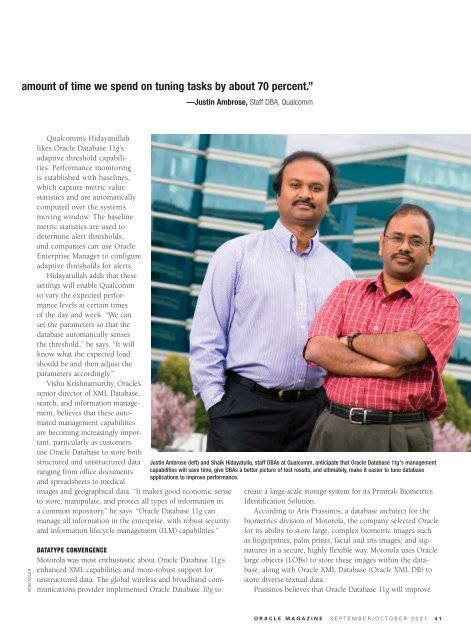Oracle Magazine - September/October 2007 - Marcelo Machado
Oracle Magazine - September/October 2007 - Marcelo Machado
Oracle Magazine - September/October 2007 - Marcelo Machado
You also want an ePaper? Increase the reach of your titles
YUMPU automatically turns print PDFs into web optimized ePapers that Google loves.
amount of time we spend on tuning tasks by about 70 percent.”<br />
BOB ADLER<br />
Qualcomm’s Hidayatullah<br />
likes <strong>Oracle</strong> Database 11g’s<br />
adaptive threshold capabilities.<br />
Performance monitoring<br />
is established with baselines,<br />
which capture metric value<br />
statistics and are automatically<br />
computed over the system’s<br />
moving window. The baseline<br />
metric statistics are used to<br />
determine alert thresholds,<br />
and companies can use <strong>Oracle</strong><br />
Enterprise Manager to configure<br />
adaptive thresholds for alerts.<br />
Hidayatullah adds that these<br />
settings will enable Qualcomm<br />
to vary the expected performance<br />
levels at certain times<br />
of the day and week. “We can<br />
set the parameters so that the<br />
database automatically senses<br />
the threshold,” he says. “It will<br />
know what the expected load<br />
should be and then adjust the<br />
parameters accordingly.”<br />
Vishu Krishnamurthy, <strong>Oracle</strong>’s<br />
senior director of XML Database,<br />
search, and information management,<br />
believes that these automated<br />
management capabilities<br />
are becoming increasingly important,<br />
particularly as customers<br />
use <strong>Oracle</strong> Database to store both<br />
structured and unstructured data<br />
ranging from office documents<br />
and spreadsheets to medical<br />
images and geographical data. “It makes good economic sense<br />
to store, manipulate, and protect all types of information in<br />
a common repository,” he says. “<strong>Oracle</strong> Database 11g can<br />
manage all information in the enterprise, with robust security<br />
and information lifecycle management (ILM) capabilities.”<br />
DATATYPE CONVERGENCE<br />
Motorola was most enthusiastic about <strong>Oracle</strong> Database 11g’s<br />
enhanced XML capabilities and more-robust support for<br />
unstructured data. The global wireless and broadband communications<br />
provider implemented <strong>Oracle</strong> Database 10g to<br />
—Justin Ambrose, Staff DBA, Qualcomm<br />
Justin Ambrose (left) and Shaik Hidayatulla, staff DBAs at Qualcomm, anticipate that <strong>Oracle</strong> Database 11g’s management<br />
capabilities will save time, give DBAs a better picture of test results, and ultimately, make it easier to tune database<br />
applications to improve performance.<br />
create a large-scale storage system for its Printrak Biometrics<br />
Identification Solution.<br />
According to Aris Prassinos, a database architect for the<br />
biometrics division of Motorola, the company selected <strong>Oracle</strong><br />
for its ability to store large, complex biometric images such<br />
as fingerprints, palm prints, facial and iris images, and signatures<br />
in a secure, highly flexible way. Motorola uses <strong>Oracle</strong><br />
large objects (LOBs) to store these images within the database,<br />
along with <strong>Oracle</strong> XML Database (<strong>Oracle</strong> XML DB) to<br />
store diverse textual data.<br />
Prassinos believes that <strong>Oracle</strong> Database 11g will improve<br />
ORACLE MAGAZINE SEPTEMBER/OCTOBER <strong>2007</strong> 41


